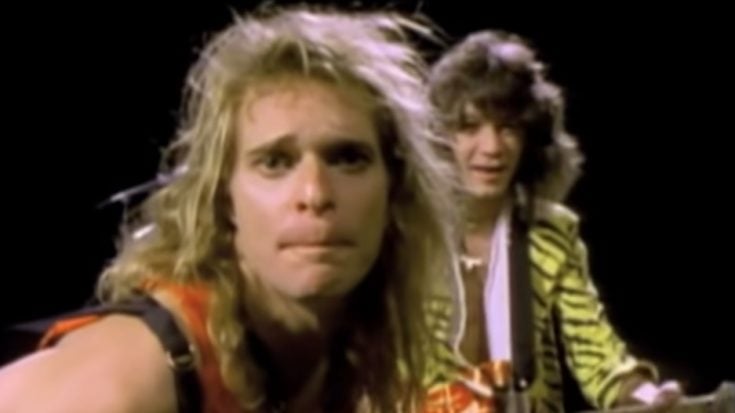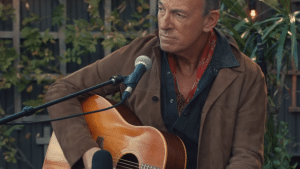The History Of Van Halen’s Conflict and Breakups

Van Halen for "Jump" - VHTelevision / Youtube
Various factors such as substance abuse, alcohol, simmering resentment, and creative disagreements have contributed to the downfall of some of the most iconic rock bands in history. In the case of Van Halen, these elements, either individually or in combination, played a role in multiple breakups involving different lineups of the legendary rock band.
The first split occurred during the peak of success for Van Halen’s original members, including singer David Lee Roth, guitarist Eddie Van Halen, bassist Michael Anthony, and drummer Alex Van Halen. Despite the monumental success of the album 1984, internally, the band was facing dissolution.
Noel Monk, the band’s manager at the time, reflected on this period in his book Runnin’ with the Devil: A Backstage Pass to the Wild Times, Loud Rock, and the Down and Dirty Truth Behind the Making of Van Halen.
He wrote, “By ’84, Van Halen, the band I loved and helped guide to fruition, was on life support, though not many people realized it. Even as 1984 racked up sales and critical acclaim, and while the band was playing one sold-out show after another, the foundation on which the band had been constructed was beginning to come apart.”
The tensions slowly widened the cracks
The tumultuous events of 1984, a principal year marked both by time and the release of the iconic album bearing the same name, witnessed the eruption of conflicts between Eddie and Diamond David.
Eddie candidly revealed his desire to quit in a 1986 interview with People, shedding light on the challenges posed by Roth’s creative nature and their offstage dynamics. “I’m not slagging him about the music. Onstage he was fine. It was offstage that he made having a human relationship impossible,” the guitarist explained.
Offstage tensions escalated as Roth consistently undermined the sanctity of marriage, subjecting Eddie and his then-wife, the acclaimed actor Valerie Bertinelli, to his belittling remarks. Compounding the interpersonal strain, Roth enacted a policy prohibiting the presence of band members’ wives backstage, further exacerbating the strained relationships within the Van Halen camp.
Musical clashes also defined the rift between Eddie and Roth. Eddie, in a bold move, began integrating synthesizers into the signature Van Halen sound, a departure that Roth vehemently opposed. Eddie recalled Roth’s criticism, quoting him via Rolling Stone, “Hey, man, you’re a guitar hero — nobody wants to see your dead ass playing keyboards.”
David Lee Roth’s side projects were the last straw
The breaking point for the remaining members of the band occurred when David Lee Roth directed his attention toward his 1985 solo EP, Crazy From the Heat, and an associated film project that, unfortunately, failed to materialize.
This shift in focus, away from crafting a follow-up to the band’s highly successful record, proved to be the proverbial last straw. In a confrontation with the band that year, Roth openly confessed his intention to move on, stating, “I can’t work with you guys anymore. I want to do my movie. Maybe when I’m done, we’ll get back together.”
Eddie, unswayed by Roth’s plans, responded assertively, declaring, “I ain’t waiting on your ass. See you later. Good luck.” This decisive exchange marked the definitive end of their collaboration.
Subsequently, in the aftermath of the breakup, Roth and the remaining members engaged in a public dispute through the music press, airing their grievances and conflicting perspectives for several months. The fallout played out in headlines and interviews, providing fans with a glimpse into the internal turmoil that led to the dissolution of one of rock’s most celebrated partnerships.
https://twitter.com/BoredWeb3/status/1416905128435757059
The Red Rocker enters, and leaves, the scene
In 1985, Sammy Hagar became a member of the band, ushering in a new era for Van Halen. The debut record with Hagar, 5150, swiftly climbed to the top spot on the charts the following year. The chemistry between Hagar and the rest of the band was palpable from the start. Hagar praised his bandmates in 1986, affirming, “They’re great guys, and they really kick some ass as musicians.”
However, the camaraderie that marked the beginning of their collaboration eventually gave way to discord. In June 1996, Eddie orchestrated Hagar’s departure from the band, citing creative differences and power struggles as the primary reasons. Bassist Michael Anthony, in the foreword to Hagar’s autobiography Red: My Uncensored Life in Rock, recalled how Eddie sought total control, with drummer Alex Van Halen aligning with his decisions, effectively marginalizing other members.
Tensions escalated as Hagar expressed dissatisfaction with the band’s direction, particularly their intent to release a greatest hits album. Furthermore, Hagar learned that other members had been clandestinely recording with David Lee Roth, intensifying his discontent.
Hagar, in a July 1996 interview with the Associated Press, conveyed his opposition, stating, “A band has a greatest hits album after they have nowhere else to go.” This marked a significant turning point in the band’s history, as internal conflicts led to Hagar’s departure and prompted a reassessment of Van Halen’s musical trajectory.
And then they reunited with Diamond Dave…
In June 1996, the original lineup of Van Halen embarked on recording two fresh tracks for the forthcoming greatest hits compilation Best of — Volume 1. Their reunion continued into September when they shared the stage as presenters at the MTV VMA Awards, as detailed in Edward Van Halen: A Definitive Biography.
However, this reunion took an unfortunate turn. Onstage, Eddie and Dave engaged in a verbal altercation over the microphone, and tensions escalated backstage. The situation reached a boiling point when Eddie, provoked by Roth’s criticism of his upcoming hip replacement surgery disclosure to the press, threatened Roth with physical violence.
Barely a month later, Roth, discovering that Van Halen had been secretly working with a new vocalist for months, expressed his outrage in an open letter distributed to various media outlets. In the letter, he claimed to have been misled into appearing with the band at the MTV event, accusing Eddie of orchestrating the deception.
He confessed, “If I am guilty of anything, I’m guilty of denial. I wanted to believe it just as much as anyone else.” Roth acknowledged that the other band members hadn’t made any promises to him, shedding light on the complex dynamics and misunderstandings that marked this tumultuous chapter in Van Halen’s history.
…Only to again leave the band bitterly
The remainder of the Van Halen members issued a comprehensive five-paragraph statement to elucidate their decision against welcoming Diamond Dave back into the fold. Eddie and Alex Van Halen, along with Michael Anthony, conveyed their rationale, stating, “We parted company with David Lee Roth 11 years ago for many reasons.”
They acknowledged that some of these reasons were reaffirmed in Roth’s open letter dated October 2. Notably, the vocalist Roth criticized was Gary Cherone, the former lead singer of Extreme.
Gary Cherone’s stint with Van Halen proved to be brief, marked by subpar record sales and a lack of fan support. Cherone contributed to a single album with the band, Van Halen III, toured in support of the record, and began collaborating on a second album before departing in 1999.
Reflecting on that period, Cherone revealed, “We came back in ’99 and we were writing stuff.” However, he noted a growing dysfunction within the group and sensed his own frustration. Cherone perceived the imminent end of his tenure with the band, pointing to signs of Eddie Van Halen’s increased drinking, which, while not severe, signaled a troubling direction for the band’s dynamics.
The band continues to struggle as internal troubles slowly tear them apart
In a 1999 interview with the El Paso Times, the Red Rocker expressed that he harbored no ill will towards Cherone but characterized the band’s collaboration with the Extreme vocalist as resembling “karaoke night”. Fast forward five years, and Hagar reemerged with Van Halen after a period of inactivity following Cherone’s departure. The resurgence coincided with Eddie Van Halen’s battle with tongue cancer, diagnosed in 2000, which went into remission in 2002.
In 2002, Anthony joined Hagar and Roth on various legs of their joint tour. By 2004, Hagar reunited with Van Halen to contribute three songs to the greatest-hits compilation The Best of Both Worlds. Notably, there was reluctance from the Van Halen brothers to involve Anthony, but Hagar insisted on his inclusion, as detailed in Eruption: Conversations with Eddie Van Halen.
Cherone, in an interview with Rolling Stone, suggested that the rift between Michael and the Van Halen brothers stemmed from Michael joining forces with Sammy, highlighting the territorial nature of the brothers who had a “you’re either with us or against us” stance.
Although the tour achieved success, internal strife resurfaced due to Eddie’s struggles with alcohol dependence and Hagar’s promotion of his Cabo Wabo tequila brand on tour. Consequently, Hagar departed, and Anthony followed suit. The band then welcomed Eddie’s son Wolfgang as the new bass player in 2006. The last Van Halen concert took place in October 2015. Sadly, five years later, in October 2020, Eddie Van Halen passed away due to complications from throat cancer, marking the end of an era for the iconic rock band.











